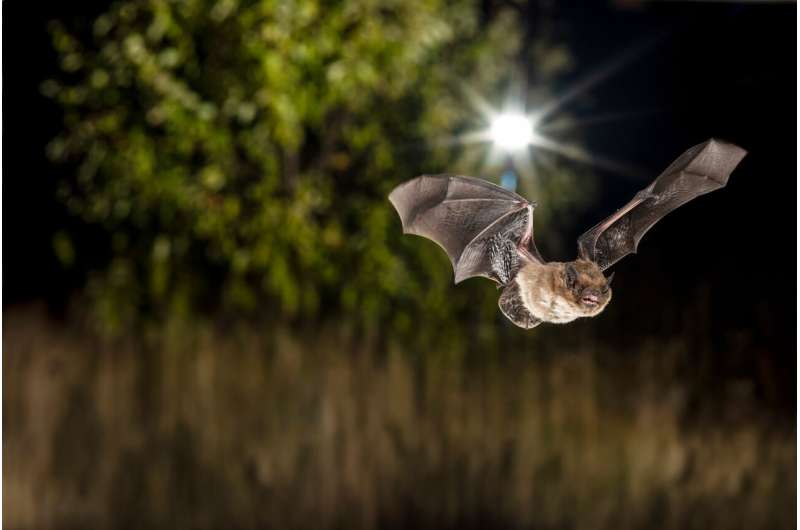How an urban bat differs from a rural bat

Some bat species are more likely to be found in cities than in the countryside. A scientific team from Freie Universität Berlin, the University of Greifswald, the Leibniz Institute of Freshwater Ecology and Inland Fisheries (IGB) and the Leibniz Institute for Zoo and Wildlife Research (Leibniz-IZW) have now investigated which characteristics are typical for urban and rural bats. The team found that bat species with higher affinity to cities are characterized by relatively low frequencies and long durations of their echolocation calls, a small body size and flexibility in the choice of their daytime roost.
The increasing urbanization of rural areas could favor these species, while relatively large species with high calling frequencies and short calling durations, as well as a specific roost choice could fall behind, the team argues in a paper in the journal Global Change Biology.
For many wild animals, cities represent extreme habitats—with higher ambient temperatures than in the immediate surroundings and a variety of disturbances caused by humans. At the same time, cities also offer a lot of potential for wildlife, such as a diverse range of roosting opportunities and an expanded food supply. For example, some bat species prefer to use roosts on or in buildings, finding a place to rest in unused attics, in cellars or in derelict houses. Some bat species reach particularly high population densities in cities, whereas they are rather rare in rural areas. But what makes an urban bat an urban bat, and a rural bat a rural bat? In which traits do urban species differ from rural species?
"Using various indices, we analyzed a global database of bat species occurrence data in terms of their spatial proximity to urban areas to derive an urban affinity value per species," explains lead author Janis Wolf, a doctoral candidate at the University of Greifswald, whose MSc thesis in the research group of Prof. Jonathan Jeschke at the Freie Uiversität Berlin and IGB formed the basis of this publication. "We used various indicators to differentiate species who tend to live in urban areas from those who tend to avoid them. We then analyzed which characteristics or traits of the species—for example average body size, wing shape, frequency of their echolocation calls or the flexibility in the choice of roost—correlated with the respective spatial preference and way of life."
Based on the traits and spatial data of 356 bat species worldwide (a quarter of the 1,400 bat species on our planet), the team determined whether the respective species tended to have a distribution focus on urban or rural areas. "Of course, most bat species are positioned along a continuum that distinguishes urban-dwelling bat species from those that tended to live in rural areas," explains PD Dr. Christian Voigt, head of the Department of Evolutionary Ecology at Leibniz-IZW.
"We found that especially small bat species, and those with echolocation calls of a relatively low frequency and long duration, which are suitable for foraging in relatively open spaces, are particularly likely to reside in cities," says Voigt. Flexibility in the choice of the day roost seems to be equally advantageous, as this allows urban-dwelling bats to switch between roosts at short notice when disturbed by humans.
During their study, the team used different proxies for describing the affinity of bats for urban environments. "Having tested multiple methodological approaches to quantify urban affinity of species, we found that the simpler indices were as good as the more complex indices, and therefore more practical and a preferred choice for future studies," concludes Dr. Yuval Itescu from IGB and Freie Universität Berlin.
This now makes it possible to apply the appropriate indices for urban affinity to other animal groups. The authors argue that identifying traits that characterize successful and less successful urban dwellers may be useful in identifying those species that are more threatened by the rapidly advancing urbanization process worldwide, and ultimately allow us to prioritize these species with regard to conservation measures.
More information: Janis M. Wolf et al, Urban affinity and its associated traits: A global analysis of bats, Global Change Biology (2022). DOI: 10.1111/gcb.16320
Journal information: Global Change Biology
Provided by Leibniz-Institut für Zoo- und Wildtierforschung (IZW) im Forschungsverbund Berlin e.V.




















